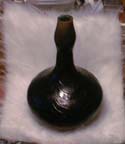
way. A way that tells you I am used to plastic, and stuff like that. My
hands ache wanting to touch them... feel the earth in them, nature, the
coolness, smell them.. just be in the same room as they are. Their very
simplicity is so elegant! The curves and shapes! Ohhh I could go on in
rhapsody over them! Thank you Jolie and NJ!
xoxo
Carolyn
Thanks for these. Very
pretty, and interesting to learn about other ways of life.
~Diana
has!!!
Teri
Hugs Cheryl D
Newbie Box Coordinator
Co Moderator
http://albums.photo.epson.com/j/AlbumIndex?u=4037954&a=30254292&pw=
Jolie, Hilda and I chat in the hallway all the time and the other
night I pulled Jolie in to show her the new beads. One thing lead to
another and I mentioned the mini pot swap. She got all excited and
said, "Wait a minute, let me go get something." and she brought over
those pots and jugs.
What she wanted to share with the mini pot swappers was some pots are
made of earth clay, some of wood and some of gourds. The gourds just
completely slipped my mind as great shapes for pots. The shapes of the
pots world wide are different than we usually think of as pot shapes.
The narrow top and wide bottom carved from one piece of wood milk jug
is just so beautiful. The bottom is slightly curved and it can be
snuggled down on an earth floor and it'll stay put. Back in the day of
the ancient Egyptians pots were pointed at the bottom, holes were dug
in the sand and the pointed bottom of the clay jar was lowered in the
hole and then the pot was pretty much buried in the sand. If this were
done in a pit, in the back of the house, and then covered, it works
like a cooler, or root cellar.
Other cultures, the Egyptians and others, used unglazed earth clay
pots to keep water cool. The porous nature of Earth clay allowed
evaporation to take place so what's inside the pot or jar is cooler
than the outside air. The outside of the pot is damp and sometimes
moss and such would try to take root on the outside of the pot, but
you'd know that the water inside is cool and delicious. Water... the
wine of the desert.
When we think of mini pots, mentally range the world wide, through out all different eras, to find different shapes. In Asia buckets and
vessels to carry liquid are often square, or an inverted triangle with
the tip cut off. It's a way to make a vessel and use straight wood
planks. There are pots that look like three milk filled breasts all
meeting at a single opening, balancing on nipples, in Peru
pre-Colombian art you see these shapes. In Asia you see the tripod
shape for vessels.
For the only definition of a vessel is that it have some space inside
to carry something, or seem to be able to carry something as in the
case of miniatures.
There are not enough mini pot swappers signed up for Dorothy's swap,
can't tell me all y'all know how to make a pinch pot. But remember you
don't have to pinch a pot together, you can cut faux wood into planks
and fashion a square tub and put a handle on it. You can make a faux
leather bucket and stitch it together. There's shapes of vessels around
the world that are ancient to them and totally new to us.
 Norajean.com
Norajean.com